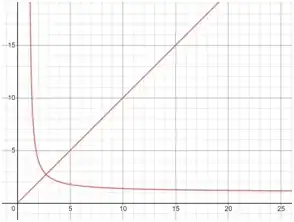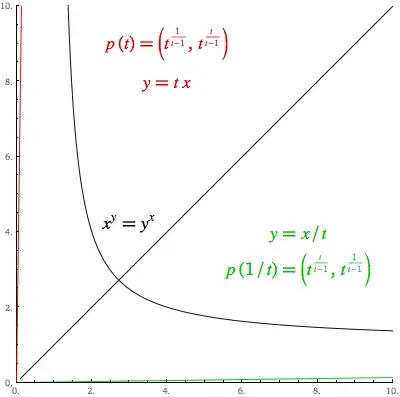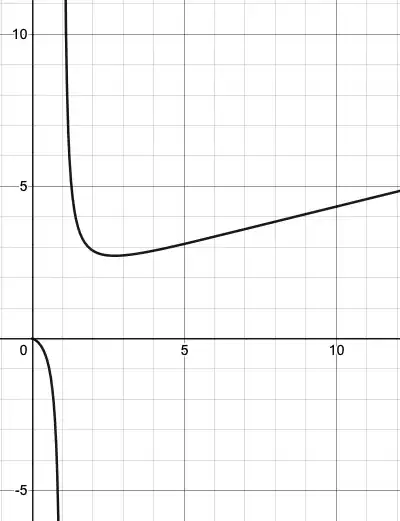I've been investigating the Cartesian graph of $x^y=y^x$. Obviously, part of the graph is comprised of the line $y=x$ but there is also a curve that is symmetrical about the line $y=x$. (We can prove this symmetry by noting that the function $x^y=y^x$ is self-inverse; all self-inverse functions are symmetrical about the line $y=x$.)
An image of the graph is shown below:
 I decided to find the intersection point and arrived at an intriguing result: the intersection point between the two curves is at $(e,e)$.
I decided to find the intersection point and arrived at an intriguing result: the intersection point between the two curves is at $(e,e)$.
The following is my method: If the gradient of the line $y=x$ is $1$, the gradient of the curve at the intersection point must be $-1$ as it's a normal to the line (as it's symmetrical about the line). This means that at that point $\frac{dy}{dx}=-1$. Now to find $\frac{dy}{dx}$.
We have $x^y=y^x$. I then used a very powerful tehnique for differentiating these sorts of functions. We know that eg $$x^y=e^{\ln{x^y}}=e^{y\ln{x}}$$ and $$\frac{d}{dx}e^{f(x)}=f'(x)e^{f(x)}$$ Applying it to our function $x^y=y^x$ and using implicit differentiation and the product rule gives us: $$(\frac{dy}{dx}\times \ln x +\frac{y}{x})x^y=(\ln y +\frac{dy}{dx}\times \frac{x}{y})y^x$$ So $$\frac{dy}{dx}x^y\ln x +yx^{y-1}=\frac{dy}{dx}xy^{x-1}+y^x \ln y$$ Extensively rearranging gives: $$\frac{dy}{dx}=\frac{y^x \ln y -yx^{y-1}}{x^y \ln x -xy^{x-1}}$$ Let $\frac{dy}{dx}=-1$: $$y^x \ln y -yx^{y-1}=xy^{x-1}-x^y\ln x$$ But we know $x=y$ since we are at the intersection point with the line $y=x$: $$x^x \ln x -x^x=x^x-x^x\ln x$$ So $2x^x \ln x -2x^x=0$ $$2x^x(\ln x -1)=0$$ This means either $2x^x=0$ or $\ln x -1=0$ but we know $x^x$ is always greater than $0$ so $\ln x =1$, leaving us with: $$x=y=e$$ So I have my answer, but is there any other method of getting it? I have heard there is. Any help will be very welcome.
Thanks in advance

